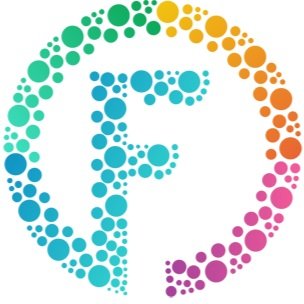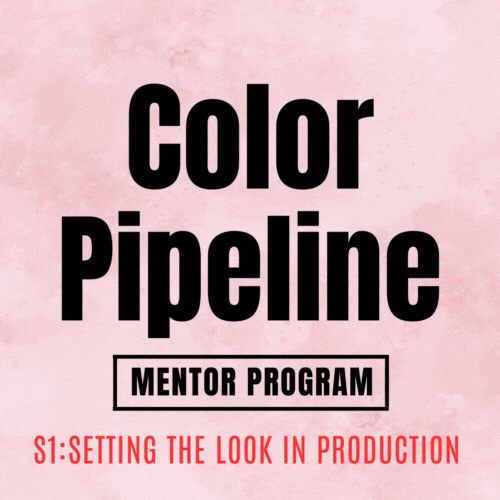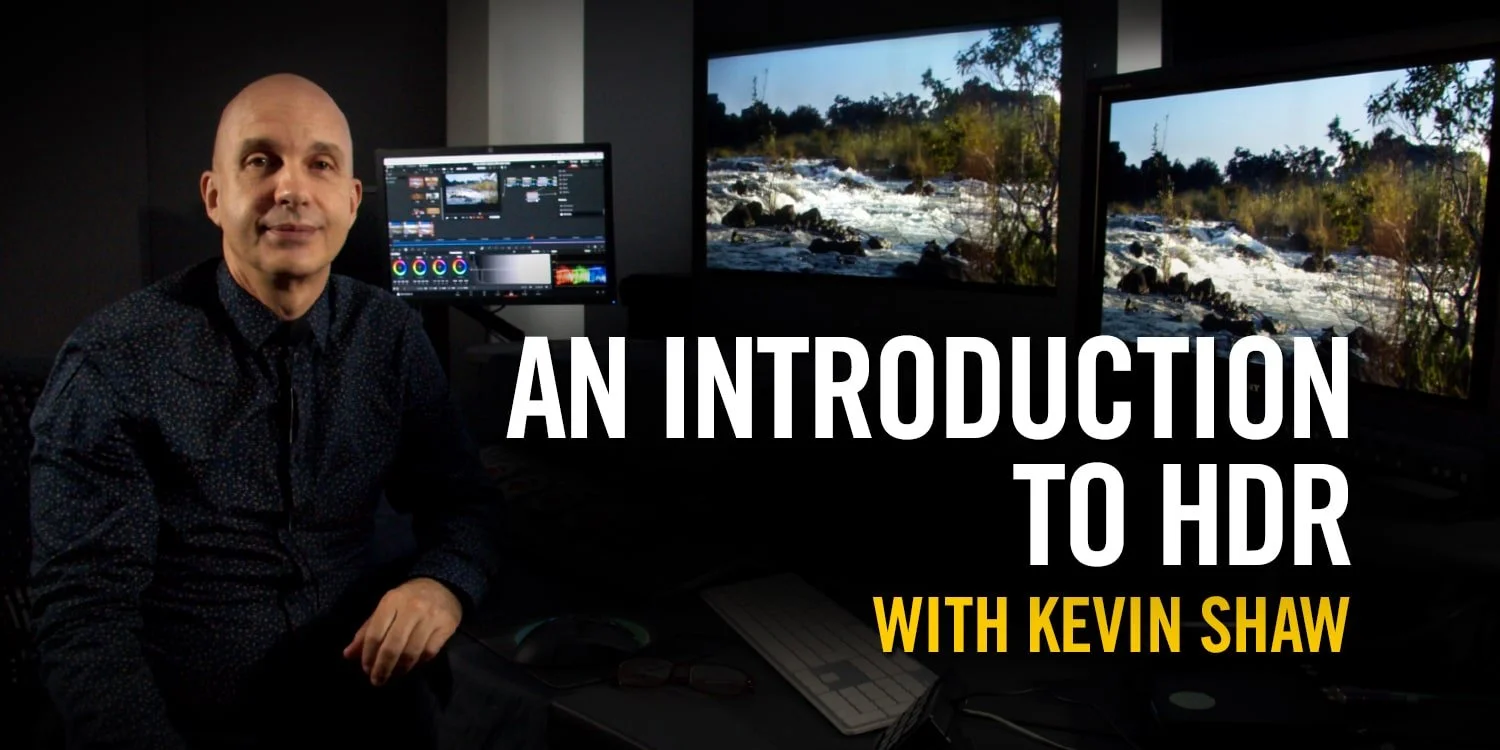
Learn at your leisure with
On demand courses
Learn from Kevin at your own pace by streaming lessons from home and practicing along with the tutorials with downloadable exercises. Upskill fast with easy-to-follow lessons & full courses
On Demand Courses:
Color Pipeline Program
Module 1 - Setting the Look in Production
Module 2 - Colour Management & Grading
Module 3 - Look Development & Grading
Each module is 15 x 60 minute videos. The complete course is about 50 hours of training! All students can contact Kevin directly with questions.
MORE DETAILS
Intro to HDR
13 lessons - theory and practice
— Color Pipeline Program —
A complete grading curriculum from on set production to post-production in 3 modules
FAST: 3 modules of 6 classes each
FLEXIBLE: Take single modules, or the full program
Your instructor, Kevin Shaw, CSI is a legend in the realm of color grading. His unique experience as a colorist, a consultant on DaVinci and Nucoda products, a professional calibrator, workflow specialist and his recent years at Mission working with DITs and Labs has made him the go-to maestro for all things color-related in the world of Color Science and Imaging. Not everyone can teach, but Kevin has taught thousands of individuals in private classes, at film schools and major companies including Amazon, Netflix, Sky, BBC, CBS, Kodak and Dolby.
The Color Pipeline Mentor Program allows participants to learn wider disciplines and is structured to help with ongoing projects during the course. Kevin has an excellent track record of identifying trends that define the future, and has been an early adopter of pipeline color management, ACES and HDR. He brings the benefits of these technologies to every project - and that is the basis of this new program. Working better costs nothing and improves everything.
Module 1: Setting the Look in Production
For: Directors, Cinematographers, DITs, Post Supervisors, VFX, Conform Artists, Assistant Colorists, Colorists and Editors
Content: Module One starts with the general principles of color science without getting too technical or theoretical. Kevin effortlessly collaborates with cinematographers and directors to ensure optimal capture of the intended visual mood. He serves as the bridge between the creative team and the technical crew.
In this module, Kevin discusses the psychology of seeing and the language of color. Production is the main focus of the later classes and we cover how camera settings affect the image. Then he explores how colorists and cinematographers tackle Look Management with color science, LUTs and CDLs and the importance of consistency.
By the end of the module, participants should understand the factors that need to be agreed and documented in workflow documents so that the Director’s vision is achieved, editors and VFX can monitor images consistent with the intended Look, and the delivery requirements are met.
Schedule:
Class 1: The Magic of Color FREE
An introduction to the program. Learn how our eyes are tricked, and how color influences our mood and emotionsClass 2: The Defining Color
Exploring color from both technical and artistic points of viewClass 3: Managing Color
Understand the differences between the appliance of science and the art of the craft
Class 4: Setting the Look in Production
Learn how cinematographers and colorists implement looks. The more you look the more you see
Class 5: Workflow Documents
How to mastermind the masterplan
Class 6: Meeting Standards
Is there anything standard about standards?
Get a taste - take intro class free!
Module 1
£360
Module 2: Color Management & Color Grading
For: Cinematographers, DITs, Post Supervisors, VFX, Conform Artists, Assistant Colorists, Colorists and Editors
Content: Module Two is more practical and begins with setting up color grading projects ready for finishing. DaVinci resolve is freely available and used as the example throughout the program, but the principles apply equally to other grading software. Kevin takes you through the interaction between editing, vfx and final color.
This Module goes further in depth into the Academy Color Encoding System (ACES), other color management solutions and the fundamentals of color grading.
By the end of Module Two participants have a thorough grasp of technical grading and matching and take away Kevin’s unique approach to optimising and tweaking images while remaining consistent to the vision captured in Production. The last two classes in the module cover Look Development using both inspiration and perspiration. Contrary to popular belief there is a huge difference between matching the Look of another film and developing that Look into something new that enhances your project. Kevin is unwavering in his commitment to perfection. He approaches each project with an insatiable hunger to understand the vision and painstakingly translates it into a meaningful reality.
Schedule:
Class 7: Project Management
Good housekeeping in the color suite, using davinci resolve as an example
Class 8: Preparing to Finish
How the plan finally comes together!
Class 9: ACES and other Color Management Systems
Flying with the ACES. Simplify the technical and focus on the creative
Class 10: Technical Grading
Primary steps to reveal the masterpiece within
Class 11: What Makes Pictures Better?
How to improve inspiration with perspiration
Class 12: HDR and SDR
The future is looking brighter but is that all there is to it?
Module 2
£360
Module 3: Look Development & Grading
For: Cinematographers, DITs, Assistant Colorists, Colorists and Editors wishing to further their color grading
Content: Module Three builds on the color knowledge of Module One and the fundamentals of Module Two to unleash the final color skills needed to elevate the visual impact of the footage. Kevin demonstrates how to subtly manipulate colors, contrast, and saturation to breathe life into the imagery, immersing the audience in captivating visual narratives. The module begins by explaining the allure of the film look and the elements that contribute to it.
Kevin continues by showing tools to isolate and spatial tools that go beyond the realm of LUTs. The focus is always on practical applications. Kevin stays at the forefront of cutting-edge technologies and industry trends, continuously refining his craft, so the program could not end without applying the knowledge and techniques gained to the broader canvas of HDR, including the latest developments from Dolby
Schedule:
Class 13: Look Management
Get your check list for matching and then developing Looks
Class 14: The Varnish
Learn tools about that are selective and put them to good use
Class 15: Skin and Sky.
Refining skin, sky and other techniques that are frequently requested
Class 16: Film Print Emulation (FPE)
The Look of film is still a major influence. See how digital processing can be more like film than film
Class 17: HDR Grading
Boldly explore the new frontiers
Class 18: Dolby Vision
Learn the wonders of Dolby Vision
Book Kevin
£150 per hour
BUY FULL COURSE
SAVE £180
-Introduction to HDR-
13 lessons to take you from standard to high definition
It’s also useful for producers, directors and designers as they encounter demand for HDR, Dolby vision, UHD Premium, Rec 2020, and wide color gamut. If you are looking for a structured HDR tutorial, this course is for you.
An HDR display is useful for the practical exercises, but not necessary for the course. Ideally, you’ll want to take this course before investing in HDR if you can, as it will save you time and money! The course utilizes Resolve to explain many of the principles but you don’t need to be an experienced colorist to get a lot of information out of the course.
CLASS 1: WHAT IS HDR?
What makes HDR displays different? Will they survive in the long term? We define dynamic range, high dynamic (HDR) range and many other terms that are related or confused with HDR. Introducing the electro-optical transfer function (EOTF) and working with HDR scopes.
CLASS 2: HDR DISPLAYS
Why is HDR so important? Is HDR future proof? Do you need an HDR display on set, in VFX , editing and grading? What HDR display is right for you today? Learn about HDR at home and in the cinema, and about the available HDR display technologies. Know the pros and cons of OLEDs and LCDs and the different types of each. Understand the UHD Premium and Dolby Vision specifications and the differences between HDR reference displays and consumer displays. How to use HDR flags and how to connect HDR displays. See how to set up HDR reference displays for grading and compare SDR and HDR signals.
CLASS 3: BETTER HIGH DYNAMIC RANGE
Why not continue to use gamma? Why is grading HDR is fundamentally different to SDR? How can HDR make better pictures? Understand the EOTFs – PQ (ST 2084) and HLG and why we need both of them. Consider the changes to bit depth, brightness, black level, and code values required by HDR. Learn how to optimize the HDR scopes. Introducing color management and ACES workflows. Learn to differentiate showcase HDR from “ordinary” HDR and consider the implications of creative intent on HDR mastering.
CLASS 4: HDR AND COLOR
Understand display color spaces and how to use wide color gamut. Working with BT. 2020. Learn to create evergreen masters. Explore the relationship between brightness and saturation and why that is important for HDR. Recognize different HDR formats and mis-matched display settings. Discover how to simulate HDR on a BT.709 display.
CLASS 5: HDR FORMATS
Why can’t we have a single HDR format? How might HDR change in the future? Learn about all the different HDR formats in use. Understand metadata and why HDR needs it. Get familiar with HDR workflows that deliver, HDR10, Dolby Vision and HLG. Know the SMPTE standards for HDR, delivery and mastering specifics and typical display standards from the UHD Alliance, Vesa and Dolby.
CLASS 6: HDR CREATION
What content can be mastered as HDR? Learn about shooting, editing, VFX and grading HDR. Setup preferences and settings for an HDR project in BMD Resolve.
CLASS 7: HDR WORKFLOWS
What is color management? How does it help Look Development? Get advice on session management. Use color science to get from camera to display formats. Understand the difference between display referred and scene referred workflows and how they affect grading. Learn about using, LUTs, transforms and converting SDR grades to HDR. Learn color management for HDR and get started with HDR grading. Discover the beauty of ACES and how to grade using it. Know the benefits of an evergreen archival master.
CLASS 8: WORKFLOW 1 – CONVERTING SDR MASTERS TO HDR
What are the limitations? How do we preserve artistic intent? Set up color managed projects to convert SDR masters to HDR. This is the first of our three essential workflows. Follow along with the BT. 709 promo project provided. Learn to exploit spectral highlights, manage clipped whites and protect subtitles. Understand color volume, HDR brightness and saturation. Control focus points and distractions.
CLASS 9: WORKFLOW 2 – CREATING THEATRICAL SDR AND HDR
The second essential workflow starts with the SDR grade, but also delivers HDR. Follow along with the project provided, containing more than 40 scenes of professionally shot Red (.r3d) footage from the documentary “Namibia – The Spirit of Wilderness“ (c) Busch Media Group”. Understand the benefits of grading with scene referred color management. Practice ACES for multiple deliverables. Learn how to make HDR trims whilst keeping the approved artistic intent. Try techniques for dark shadows, bright backgrounds, and colorful highlights. Understand when to use HDR for effect and what increased color volume looks like. Learn to deliver different HDR formats from the evergreen master.
CLASS 10: WORKFLOW 3 – CREATING HDR FOR OTT PLATFORMS
The third essential workflow starts with the HDR grade and still delivers SDR formats as well. Practice working on HDR skies, detail and lighting effects. Manage the average picture level (APL) to optimize both the HDR and SDR masters. Work with alternative ways to tone map and trim HDR to SDR.
CLASS 11: GRADING HDR
Discover techniques to minimize distractions and optimize HDR. Learn the main differences between SDR and HDR grading. Manage noise, black clipping, dark night scenes, bright exterior scenes, water, contrast and white clipping.
CLASS 12: DELIVERING HDR
How long does it take to grade HDR? Learn about file naming conventions. Understand Resolve export settings, HDR and SDR delivery formats.
CLASS 13: DOLBY VISION MASTERING
What do you get with a Dolby Vision license? What grading software supports Dolby Vision? Learn the Dolby Vision workflow, metadata and trims. Setup a Dolby Vision project in Resolve, analyze shots, tone map with the iCMU. and see the Dolby Vision trim tools in action. If you have a Dolby Vision License you can also practice Dolby Vision trims.
Course targeted towards colorists, VFX artists, DIT, editors, and more
This is an introductory level course ideal for colorists, engineers, cinematographers, DITs, VFX artists, and editors involved in HDR pre-production, production and post-production.
High Dynamic Range (HDR) has been available to consumers since 2016 and has been widely adopted in media and entertainment. But, do you really know what HDR is? This course, taught by Kevin Shaw, is much more than a tutorial. Structured classes will help you master HDR, learn about HDR displays, and how to grade HDR content. You’ll understand the different HDR formats, including Dolby Vision, HDR10 and HLG. While most of the course aims to be application-agnostic (HDR theory and not button pushing), you will also learn how to set up and grade HDR in DaVinci Resolve.
HDR is unanimously claimed as better, but it significantly affects workflow from capture and mastering through to delivery and display. With a deeper knowledge of HDR workflows, formats, and display technologies, you can better invest, implement and explore the possibilities the tech brings. Learn to differentiate good HDR from poor HDR and showcase HDR from technical HDR.
Aim of the course: learn new skills for HDR
This course is much more than a one-off tutorial. Learn to take full advantage of new workflows and develop new skills for high dynamic range content. Experience how lighting, editing and grading are affected, and which tools are most useful to achieve bigger, better color. Learn the three essential workflows for HDR mastering. The course covers critical concepts and practical considerations for HDR production, workflow, grading, mastering, distribution, and viewing. You will also build your vocabulary around HDR and communicate effectively in technical and creative related discussion.
Materials provided in the downloads for the course
You will receive instruction in 13 class movies filmed at Dolby London, as well as three Resolve archives with projects and media to grade.
Project 1 has test images and raw content from the BlackMagic Design BMPCC 6k camera
Project 2 is an SDR quicktime promo that you will trim to HDR
Project 3 is more than 40 scenes of professionally shot Red (.r3d) footage from the documentary Namibia – The Spirit of Wilderness ( ©Busch Media Group)
This course includes over 7.5 hours of recorded sessions with practical demonstrations using DaVinci Resolve for on-demand playback and practice.
Module 3
£360
Have a technical problem you need solved? Want to hone a niche technical skill? Need guidance with your latest project? Borrow my 30+ years of grading expertise to help get the job done.
Book private online classes or consulting sessions by the hour via Zoom or similar. Sessions are one-on-one only and can be used for training, advice, or help with grades. We can share desktops and exchange setups to explore new techniques or trouble shoot your current workflow.
Module 1-3
£900
An Introduction to HDR
$199
Hear what past students say about Kevin’s classes: who would benefit from attending, why they opted for Kevin, and what they gained from the experience










